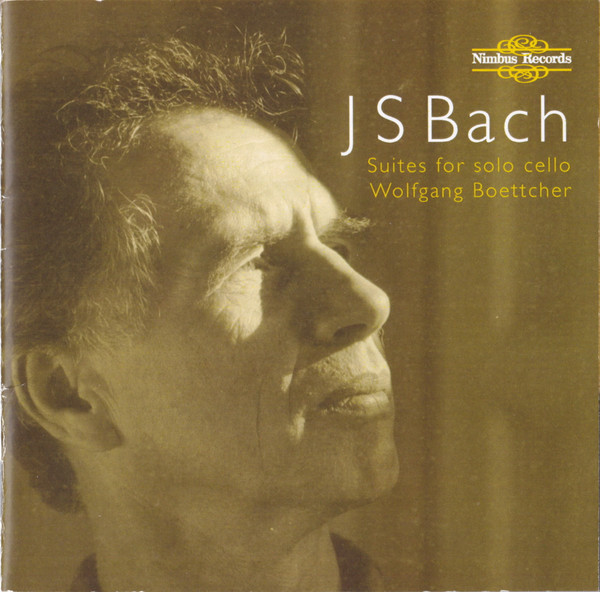
Wolfgang Boettcher. Bach Cello Suites Nimbus Records CD NI 5834/5.
Recorded October 2000 and March 2001 Waystone studios Monmouth UK.
Released 2008.
Cello used: Matteo Goffriller 1722. Variety of bows including baroque used detailed in notes.
Introduction.
This is the second recording by Boettcher of the complete Suites at the age of 66. His earlier recording on vinyl for the Cercle Kallistos label was released in 1989. There is currently a copy of that recording for sale at over £1000!
The Cellist.
Boettcher was born in Berlin under the shadows of looming war in 1935. Ultimately he became lead cellist of the Berlin Philharmonic Orchestra and performed as soloist with the likes of Karajan, Menuhin and Fischer-Dieskau. He was one the original “12 Cellisten der Berliner Philharmoniker”. He performed as a piano trio with his two sisters. Boettcher gives an interesting insight into his training and philosophy within a section of the accompanying CD booklet with references to literature related to Bach and cello technique. Plenty of fodder for any ardent listener!
The recording.
This recording is labelled as having Stereo Ambisonic, and is UHJ encoded. This apparently has been devised to broaden the sound stage when listening using two speakers and no doubt other enhancements. Sadly without a UHJ decoder these benefits are unobtainable and I suspect the limited number of recordings with this coding do not make the process worthwhile unless one were an enthusiast about these matters. The CD should play on a standard CD player but without the enhanced sound. Needless to say my fussy NAIM CD player would not play the CD! I resorted to ripping the CD to my computer and playing via DAC attached to my hi fi.
Despite the limitations of my play back the overall sound does impress with a spacious sound stage and lovely open sound. There is little extraneous and unwanted noise from the performer.
Boettcher impresses with a light airy tone from his Goffriller, a cello used by a number of big tone cellists such as Starker and Zuill Bailey. However with presumably gut strings he manages to restrain himself for the most part with unforced musical and dynamic playing. The cello has a pleasant “woody” sound and there is not too much scratchiness from the strings as can be evident with some baroque interpretations. I would group this performance with other Baroque recordings but particularly the Sarabandes are played in a more legato style here.
The music.
From the off the first Prelude impresses and draws the listener in with gentle undulations in the phrasing. There is a conversational character as well to the phrasing with statement and response throughout. Boettcher is clearly at pains to interest the listener with repeats significantly varied in both volume and use of ornaments. At all times the music has a clear sense of momentum and direction of travel. The dances particularly are rhythmic and the timing tight with good articulation. There is modest rubato particularly at the start and end of subsections of each movement.
Within a section of the CD booklet written by Boettcher he comments that his teacher Richard Klemm advised him strongly to observe the hierarchy of the beat with Bach’s Suites. I feel he has listened carefully to his teacher.
A feature I enjoy particularly is the way in which Boettcher plays Sarabandes with significant improvisation during repeats which take the form of ornaments extending into modulations of key which are striking but pleasing on my ear at least!
Another unusual if not unique feature of this recording is the playing of some passages in the 4th Bourrée and 6th Gavotte pizzicato. I’m not sure what if anything it adds but it certainly does not detract and raises interest.
The fifth Prelude I found particularly absorbing with a typical grand introduction employing the full power of the Goffriller cello but then in contrast a very nimble and light fugal passage which became stronger and stronger with very powerful ending. The image in my mind was of a small child running away from its parents (the strong introductory passage). Gradually the child over time gets stronger and more confident before developing into a young adult (the ending).
Some niggles.
Throughout the performance there are slight intonation issues which were enough to detract from my enjoyment a little. I think it might be that I came to this recording from another which was very accurate. Alternatively it could be that I am unappreciative of a form of expressive intonation perhaps somewhat exaggerated by the cellist in question. Casals was known for his use of this device. This link goes into the matter in far more detail than I can understand but you may find it interesting!
https://www.thestrad.com/for-subscribers/cellist-pablo-casals-on-expressive-intonation/1434.article
The other niggle is that the sixth Suite seemed to lack some of the musicality and dynamics presented within the rest of the performance. This may be a technical issue but it did seem almost lacklustre instead of being the climax of the whole six Suites.
Summary.
I find this performance very pleasing and easy on my ear. It seems to have a natural “organic” feel. I feel the term organic is often overused but in this case may be appropriate! My only minor reservations lie with the intonation and the slightly disappointing sixth Suite.
Charles.